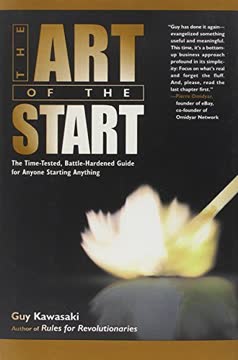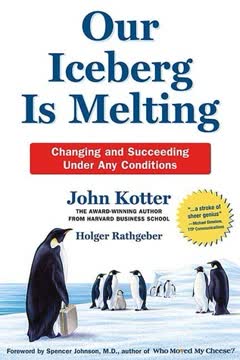Key Takeaways
1. Embrace Change: Urgency is Essential for Organizational Transformation
By far the biggest mistake people make when trying to change organizations is to plunge ahead without establishing a high enough sense of urgency in fellow managers and employees.
Complacency is the enemy of change. Organizations often fail to transform because they underestimate the power of complacency and don't create a sufficient sense of urgency. Complacency can stem from:
- Past success and the absence of visible crises
- Low performance standards and lack of external feedback
- Organizational structures that focus on narrow functional goals
- Internal measurement systems that emphasize the wrong metrics
To increase urgency:
- Create a crisis by exposing major weaknesses
- Set ambitious targets that can't be reached by business as usual
- Provide more customer and financial performance data to employees
- Insist on frank discussions about problems in management meetings
2. Build a Powerful Guiding Coalition to Lead Change Efforts
A strong guiding coalition is always needed—one with the right composition, level of trust, and shared objective.
Teamwork at the top is crucial. Major change is impossible unless the head of the organization is an active supporter, but the effort requires a powerful coalition beyond just one leader. This coalition should have:
- Position power: Enough key players to lead the change
- Expertise: Relevant perspectives for making informed decisions
- Credibility: A good reputation to be taken seriously
- Leadership: Proven change leaders to drive the process
To build an effective coalition:
- Find the right people with a combination of skills and traits
- Create trust through carefully planned off-site events and activities
- Develop a common goal that appeals to both head and heart
3. Create and Communicate a Compelling Vision for Change
Vision refers to a picture of the future with some implicit or explicit commentary on why people should strive to create that future.
A clear vision guides the change effort. An effective vision serves three important purposes:
- Clarifies the general direction for change
- Motivates people to take action in the right direction
- Helps coordinate the actions of different people efficiently
Characteristics of an effective vision:
- Imaginable: Conveys a clear picture of the future
- Desirable: Appeals to long-term interests of stakeholders
- Feasible: Contains realistic, attainable goals
- Focused: Clear enough to guide decision-making
- Flexible: Allows for individual initiative and alternative responses
- Communicable: Can be explained quickly and easily
4. Empower Employees to Act on the Vision
Without sufficient empowerment, critical information about quality sits unused in workers' minds and energy to implement changes lies dormant.
Remove barriers to change. Even when employees understand and support the vision, they may feel disempowered by obstacles in their path. Common barriers include:
- Organizational structures that undermine the vision
- Lack of needed skills or training
- Personnel and information systems that are misaligned with the vision
- Supervisors who discourage actions toward implementing the vision
To empower employees:
- Align structures, skills, systems, and supervisors with the new vision
- Communicate the vision clearly and consistently
- Provide training to develop necessary skills
- Align information and personnel systems to support the vision
- Confront supervisors who undercut needed change
5. Generate Short-Term Wins to Maintain Momentum
Running a transformation effort without serious attention to short-term wins is extremely risky.
Plan for and create visible performance improvements. Short-term wins serve multiple purposes:
- Provide evidence that sacrifices are worth it
- Reward change agents with recognition
- Help fine-tune vision and strategies
- Undermine cynics and resisters
- Keep bosses on board
- Build momentum
Characteristics of a good short-term win:
- Visible: Many people can see the results
- Unambiguous: Little argument over the call
- Clearly related to the change effort
To generate short-term wins:
- Plan for visible performance improvements
- Create those improvements
- Recognize and reward people involved in the improvements
6. Consolidate Gains and Produce More Change
Whenever you let up before the job is done, critical momentum can be lost and regression may follow.
Don't declare victory too soon. After some success, there's a tendency to let up on the urgency and momentum. However, change efforts often require years to fully anchor in an organization's culture. To consolidate gains and produce more change:
- Use increased credibility from short-term wins to tackle bigger problems
- Bring in additional people to help with the changes
- Keep urgency levels up and maintain clarity of shared purpose
- Manage multiple change projects through empowered employees
- Identify and eliminate unnecessary interdependencies
Key aspects of this stage:
- More change, not less
- More help from additional people
- Leadership from senior management to maintain focus
- Project management and leadership from lower levels
- Reduction of unnecessary interdependencies
7. Anchor New Approaches in the Organizational Culture
Culture changes only after you have successfully altered people's actions, after the new behavior produces some group benefit for a period of time, and after people see the connection between the new actions and the performance improvement.
Make change stick by rooting it in the culture. Culture – the norms of behavior and shared values of a group – is powerful because:
- Individuals are selected and indoctrinated well
- The culture manifests itself through the actions of many people
- It happens without much conscious intent, making it hard to challenge
To anchor change in culture:
- Come last, not first: Most changes in norms and values occur at the end of the transformation process
- Depend on results: New approaches sink into culture after it's clear they work
- Require a lot of talk: Verbal support and instruction help people accept new practices
- May involve turnover: Sometimes changing key people is necessary
- Make decisions on succession crucial: Promotion processes must be compatible with new practices
8. Leadership, Not Just Management, is Crucial for Successful Change
Management is a set of processes that can keep a complicated system of people and technology running smoothly. Leadership is a set of processes that creates organizations in the first place or adapts them to significantly changing circumstances.
Develop leadership throughout the organization. While management is about coping with complexity, leadership is about coping with change. In a world of increasing change, organizations need more leadership at every level. To develop leadership:
- Create flatter, leaner structures that allow people to lead
- Foster less controlling and more risk-taking cultures
- Encourage people to attempt to lead, starting on a small scale
- Provide coaching and encouragement to help people grow
The organization of the future will need:
- A persistent sense of urgency
- Teamwork at the top
- People who can create and communicate vision
- Broad-based empowerment
By developing these capabilities, organizations can better navigate the increasingly complex and rapidly changing business environment of the 21st century.
Last updated:
FAQ
What's "Leading Change" about?
- Focus on Change Management: "Leading Change" by John P. Kotter is a seminal work on change management, providing a comprehensive framework for leading organizational transformations.
- Eight-Stage Process: The book outlines an eight-stage process for successful change, emphasizing the importance of leadership over management in driving change.
- Addressing Complacency: It highlights the common pitfalls organizations face, such as complacency and lack of urgency, and offers strategies to overcome them.
- Vision and Culture: Kotter stresses the importance of creating a compelling vision and embedding new approaches into the organizational culture to ensure lasting change.
Why should I read "Leading Change"?
- Proven Framework: The book offers a proven framework for managing change, which has been widely adopted across industries.
- Practical Insights: It provides practical insights and real-world examples that can be applied to various organizational contexts.
- Leadership Focus: Kotter emphasizes the role of leadership in change, making it essential reading for current and aspiring leaders.
- Timeless Relevance: Despite being published in 1996, the principles remain relevant in today's fast-paced business environment.
What are the key takeaways of "Leading Change"?
- Urgency is Crucial: Establishing a sense of urgency is the first and most critical step in the change process.
- Guiding Coalition: Building a strong guiding coalition is essential for driving change and overcoming resistance.
- Vision and Communication: Developing a clear vision and effectively communicating it are vital for aligning and motivating stakeholders.
- Cultural Anchoring: For change to stick, new practices must be anchored in the organization's culture.
What is John P. Kotter's eight-stage process for change?
- Establish Urgency: Create a sense of urgency to motivate people to move out of their comfort zones.
- Build a Coalition: Form a powerful guiding coalition to lead the change effort.
- Develop Vision and Strategy: Craft a clear vision and strategy to guide the change.
- Communicate the Vision: Use every vehicle possible to communicate the new vision and strategies.
- Empower Broad-Based Action: Remove obstacles and empower people to act on the vision.
- Generate Short-Term Wins: Plan for and create short-term wins to build momentum.
- Consolidate Gains: Use increased credibility to change systems, structures, and policies that don't fit the vision.
- Anchor New Approaches: Reinforce the changes by anchoring them in the corporate culture.
How does Kotter differentiate between management and leadership in "Leading Change"?
- Management vs. Leadership: Management is about coping with complexity, while leadership is about coping with change.
- Planning vs. Visioning: Managers plan and budget, whereas leaders set direction by developing a vision.
- Organizing vs. Aligning: Managers organize and staff, while leaders align people by communicating the vision.
- Controlling vs. Motivating: Managers control and solve problems, whereas leaders motivate and inspire.
What are the common mistakes organizations make during change, according to Kotter?
- Complacency: Allowing too much complacency can derail change efforts before they start.
- Weak Coalition: Failing to create a sufficiently powerful guiding coalition can lead to stalled initiatives.
- Undercommunicating Vision: Not communicating the vision effectively can result in confusion and resistance.
- Declaring Victory Too Soon: Celebrating success prematurely can lead to regression and loss of momentum.
What role does vision play in successful change, according to "Leading Change"?
- Direction and Clarity: A vision provides direction and clarity, simplifying decision-making processes.
- Motivation: It motivates people to take action, even when it involves personal sacrifices.
- Alignment: A shared vision helps align individual actions with organizational goals.
- Communication: A clear and compelling vision is essential for effective communication and buy-in.
How can organizations overcome resistance to change, based on Kotter's advice?
- Create Urgency: Establish a sense of urgency to overcome complacency and resistance.
- Build Trust: Develop a guiding coalition with trust and shared objectives to lead the change.
- Empower Employees: Remove obstacles and empower employees to take action aligned with the vision.
- Short-Term Wins: Generate short-term wins to build momentum and undermine cynics.
What are the best quotes from "Leading Change" and what do they mean?
- "Speed of change is the driving force. Leading change competently is the only answer." This highlights the necessity of effective leadership in navigating rapid changes.
- "Management is a set of processes that can keep a complicated system of people and technology running smoothly. Leadership is a set of processes that creates organizations in the first place or adapts them to significantly changing circumstances." This quote underscores the distinction between management and leadership.
- "Without credible communication, and a lot of it, employees' hearts and minds are never captured." It emphasizes the importance of communication in gaining buy-in for change.
- "Whenever you let up before the job is done, critical momentum can be lost and regression may follow." This warns against complacency and the premature celebration of success.
How does Kotter suggest organizations anchor new approaches in their culture?
- Link to Performance: Demonstrate how new behaviors and attitudes have improved performance.
- Consistent Communication: Use verbal instruction and support to reinforce new practices.
- Leadership Succession: Ensure that promotion criteria align with the new culture to sustain change.
- Cultural Integration: Address cultural inconsistencies and integrate new practices into the core values.
What implications does "Leading Change" have for the future of organizations?
- Continuous Urgency: Organizations must maintain a persistent sense of urgency to adapt to rapid changes.
- Teamwork at the Top: Effective teamwork among top executives is crucial for navigating complex environments.
- Leadership Development: Developing leadership skills at all levels is essential for sustaining change.
- Adaptive Cultures: Organizations need adaptive cultures that support change and innovation.
How can individuals develop leadership skills for the twenty-first century, according to Kotter?
- Lifelong Learning: Embrace lifelong learning to continuously develop leadership skills.
- Risk Taking: Be willing to take risks and step out of comfort zones to grow.
- Self-Reflection: Engage in humble self-reflection to learn from successes and failures.
- Openness to Ideas: Remain open to new ideas and actively solicit feedback from others.
Review Summary
Leading Change receives generally positive reviews for its insights on organizational change, with readers praising Kotter's eight-stage process and distinction between management and leadership. Many find it applicable to various settings, though some critique its focus on large corporations. Reviewers appreciate the practical advice but note the writing can be dry. While some find it revolutionary, others see it as common sense. Overall, it's considered a valuable resource for those involved in change management, despite occasional criticisms of its generalized approach.
Similar Books







Download PDF
Download EPUB
.epub digital book format is ideal for reading ebooks on phones, tablets, and e-readers.










